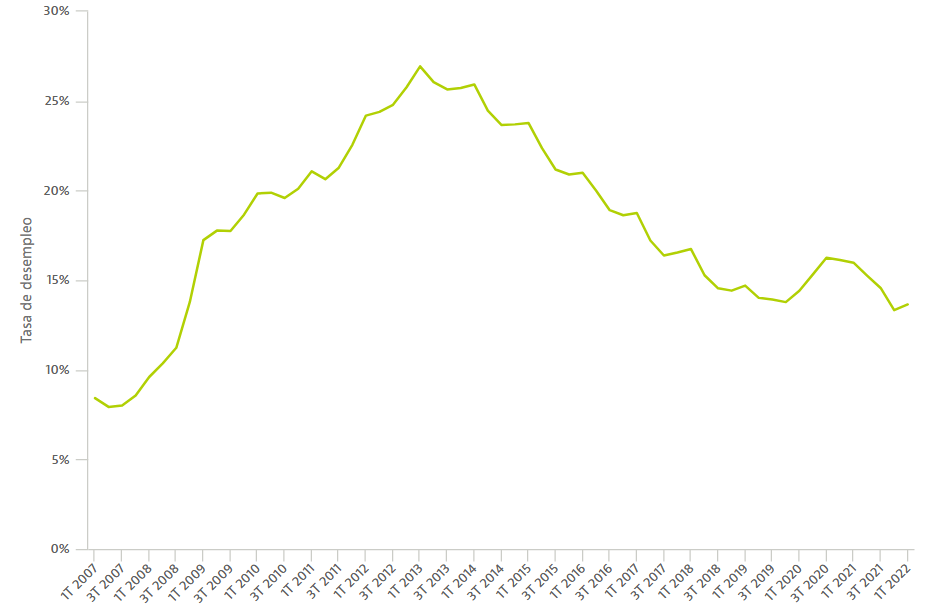
Unemployment in Spain rose by 70,900 people between January and March 2022, which is almost 2.3% more than in the previous quarter at the end of 2021, while employment fell by 100,200 jobs (-0.5%), its smallest decline in a first quarter since 2019, when 93,400 jobs were lost. Let's have a closer look at Spain's unemployment rate in 2022 and Spain's unemployment rate by year.
Unemployment rate in Spain 2022
At the end of March 2022, the total number of unemployed stood at 3,174,700 people and the number of employed at 20,084,700, according to the Spanish Labour Force Survey (Encuesta de Población Activa, EPA) for the first quarter published by the Spanish National Statistics Institute (INE).
The increase in unemployment in the first quarter of 2022 contrasts with the fall of 65,800 unemployed people recorded in the same period of 2021. In the first three months of 2020, when the Covid-19 pandemic hit, unemployment rose by 121,000 people, more than it did in the first quarter of this year.
The unemployment rate rose by three tenths of a percentage point in the first quarter to 13.65%, while the activity rate fell by just over one tenth of a percentage point to 58.5%, after the number of people in work fell by 29,400 between January and March (-0.1%). However, in year-on-year terms the unemployment rate fell by more than two points. In fact, INE calculates that in the last 12 months, unemployment has fallen by 479,200 people (-13.12%).
One million households in Spain with all members unemployed
Households with all members unemployed rose by 29,000 in the first quarter, 2.8% over the previous quarter, to 1,052,900. However, over the last year, households with all members unemployed have fallen by 173,300, representing a relative decline of 14.1%.
Between January and March 2022, households with all members in employment fell by 22,300 (-0.2%) to a total of 11,049,700 households. However, in the last year, households with all members in employment have increased by 630,800 (+6%).
On the other hand, the INE highlights that households with at least one employed member rose by 23,400 in the first quarter (+0.17%), to 13.7 million, while in the last year they increased by 235,500 (+1.7%). And households with no employed members rose by 26,100 between January and March (+0.5%) to 5.28 million. Over the last year, these households have fallen by 60,300 (-1.1%).
Spain unemployment rate by region 2022
Valencia, Cantabria, Andalusia and Catalonia were the only Spanish Autonomous Communities that saw reduced unemployment in the first quarter of 2022 compared to the last quarter of 2021.
Compared with the first quarter of 2021, unemployment fell in all the autonomous communities, with the exception of the Balearic Islands, Ceuta and Melilla. In this case, the year-on-year decrease by Autonomous Community was 13.12%, with 479,200 fewer unemployed.
Unemployment fell by 10.66% in the Autonomous Community of Valencia, with 37,900 fewer unemployed. In Cantabria, the fall was 9.3%, with 2,900 fewer unemployed, while in Andalusia, the fall in unemployment in the first quarter of the year was 5.88%, with 45,900 fewer unemployed. In Catalonia, unemployment also fell, albeit more moderately, by 0.31% and 1,200 fewer unemployed between January and March.
In the first quarter of the year, the Balearic Islands was the region where unemployment rose the most, with an increase of 24.54% compared with the previous three months and 23,100 more unemployed people. Increases were also recorded in Asturias (19.29%, with 8,500 more unemployed), Madrid (19.17% and 68,500 more unemployed), or Ceuta (18.88% and 1,900 unemployed).
Spain unemployment rate 2007-2022
